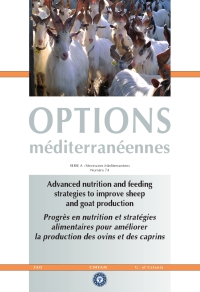| Article précédent | p. 331-336 | Article suivant |
Feeding behaviour adjustments by ewes foraging in highly heterogeneous and temporally variable environments
The European agri-environmental policy is encouraging livestock farmers to adopt grazing practices that contribute to biodiversity conservation. But there is a serious lack of knowledge, and a better understanding of feeding behaviour adjustments in response to diversity is needed. In order to address this question, we conducted two on-farm experiments with flocks of dry ewes foraging broom shrublands. A direct in situ observation method was used, with continuous observation of ingestive bites taken by a continuously monitored individual per experiment. A bite coding-grid enabled us to distinguish the extreme diversity of bites masses and structure. Flock activities were also scan-sampled, in order to check the consistency of individuals' behaviour with those of their flocks. Daily dry matter intakes (DMI) were high in both experiments: 77.9±10.2 and 75.1±16.9 g DMI/kg LW0.75, which is twice higher than predictions from existing models on sheep intake. Our data enabled us to explore the relationship between the quantitative daily intakes and the diversity of instantaneous feeding behaviour. Daily averages of ingestive behaviour hide the extremely large range of instantaneous values (from 0.04 to 1.2 g DM for bite mass). When vegetation size and structure declined as a result of grazing, the ewes progressively took larger bite masses with equivalent nutritive quality, thus adopting a pattern of consumption that is not consistent with the general assumption that such bites are chosen during the first days, as a result of the quantity-quality trade-off. This research provides knowledge about which type of diversity in plant parts offers a small ruminant satisfying behavioural leeway in composing its meals and reaching satiety.
Les politiques environnementales européennes encouragent aujourd'hui des pratiques de conduite de troupeaux afin de contribuer à la conservation de la biodiversité. Mais les connaissances disponibles font défaut pour la rédaction des recommandations. Afin de mieux comprendre les ajustements comportementaux réalisés par les petits ruminants d'élevages, nous avons conduit deux expériences en ferme, dont les lots de brebis taries sont conduits sur des landes à genêt. La méthode utilisée est celle de l'observation directe in situ et en continu des prises alimentaires réalisées par un individu durant la journée, complétée par des observations par scan-sampling des activités du lot. Aucune variation inter-quotidienne des quantités ingérées en matière sèche n'est détectée. Ces quantités (77.9±10.2 et 75.1±16.9 g MSI/kg PV0.75) sont plus importantes que ce qui est prévu par la littérature concernant des régimes à base de fourrages verts de qualité équivalente. Les jeux de données très précis ont rendu possible une confrontation de ces bilans journaliers avec la grande diversité des principales variables décrivant le comportement d'ingestion. Les moyennes quotidiennes cachent en réalité des valeurs instantanées couvrant une gamme considérable (de 0,04 à 1,2 g MS pour les masses des prises alimentaires). Nous observons des ajustements comportementaux contredisant l'hypothèse assez générale d'une sélection prioritaire des prises alimentaires de masse élevée et de bonne valeur nutritive. Celles-ci ne sont incluses dans les régimes qu'au cours des derniers jours passés dans un parc clôturé. Ces résultats contribuent à pouvoir qualifier mieux qu'auparavant le type de diversité à offrir à des petits ruminants pour leur permettre une bonne organisation de leur ingestion.
- [ Afficher ]
- [ Télécharger ]
- [ Exporter la citation ]
Vous pouvez télécharger la citation au format :
- [ Imprimer ]
-
Mots-clés
BREBIS, COMPORTEMENT ALIMENTAIRE, EXPERIMENTATION, NIVEAU D'ALIMENTATION, PATURAGE, PRISE ALIMENTAIRE (ANIMAUX)Citer cet article
Agreil C., Meuret M. Feeding behaviour adjustments by ewes foraging in highly heterogeneous and temporally variable environments. In : Priolo A. (ed.), Biondi L. (ed.), Ben Salem H. (ed.), Morand-Fehr P. (ed.). Advanced nutrition and feeding strategies to improve sheep and goat . Zaragoza : CIHEAM, 2007. p. 331-336. (Options Méditerranéennes : Série A. Séminaires Méditerranéens; n. 74). 11. Seminar of the FAO-CIHEAM Sub-Network on Sheep and Goat Nutrition, 2005/09/08-10, Catania (Italy). http://om.ciheam.org/om/pdf/a74/00800398.pdf



